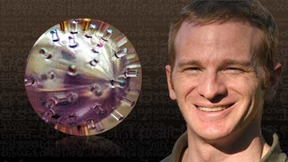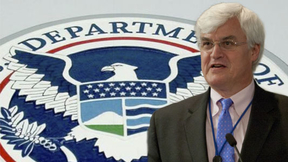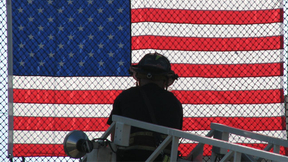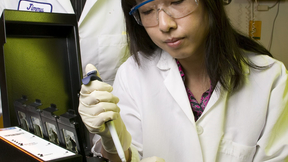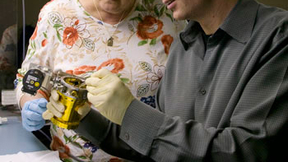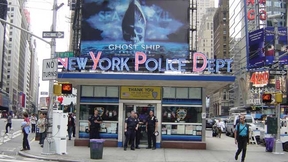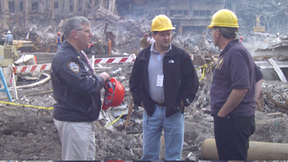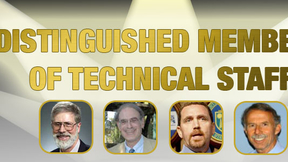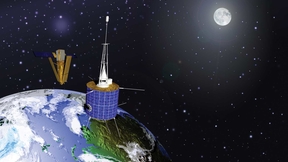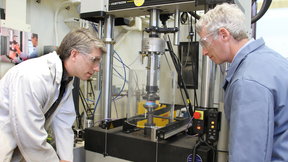Back
Don Roberts, of the Lab's Weapons and Complex Integration Directorate, is the latest recipient of the National Nuclear Security Administration's Defense Programs' Employee of the Quarter Award. Roberts, a Design Group Leader in B Division, was recognized for "leading a multidisciplinary, international team in the first-ever Insensitive High Explosive velocimetry pin…
Picture this: You've brought your sick child to the doctor's office. After checking her pulse and blood pressure, he takes a nasal or throat swab and inserts it into a mysterious black box. Before the doctor finishes his examination, the black box beeps, indicating that the pathogen that's making your child sick has been identified. Sound far-fetched? Actually, this…
Editor's note; The following is part of an ongoing series looking back at the events surrounding 9/11. Today's feature looks at the role the Laboratory played in establishing the Department of Homeland Security. On the morning of Sept. 11, 2001, Parney Albright already had spent 16 years working in national security. That morning, on a military base just outside Washington…
What has become a solemn Lab tradition, a brief yet poignant ceremony was held Monday near the Superblock to commemorate the lives lost on Sept. 11, 2001 in New York City, the Pentagon, Washington D.C. and Pennsylvania. "Please pray for those who carry on without their loved ones," Chris Holm of the Superblock said during the program's introduction. Lab employee Jennifer…
Editor's note -- This is the final article in a series on the Lab's response to the 9/11 attacks. Today's feature looks at the Lab's role in protecting the nation against bioterorrism. In trying to protect the nation against bioterrorism, national lab and university scientists, public health authorities and law enforcement agencies have waged the fight on many fronts…
Editor's note: As the 10th anniversary of 9/11 approaches, Newsline is running a series of articles on the Lab's response to events following the attacks. Today's story looks at the Lab's contributions to radiation detection. September 11, 2001 served as a turning point for the United States. The first major attack on U.S. soil in nearly 60 years and the largest loss of…
Editor's note: This is the second in a series of stories looking back at the Lab's response to events following Sept. 11. Today's piece focuses on the Lab's role in establishing BASIS - the Biological Aerosol Sentry and Information System - and BioWatch. By Stephen Wampler Telephone calls awakened Tom Slezak, Kris Montgomery and Cheryl Strout and Julie Avila at their homes…
Editor's note: This is the first in a series of articles looking back at the Lab's response immediately following the Sept. 11 attacks and the Lab's response since that day 10 years ago. Today's article is adapted from a column by Wayne Shotts, the former head of the Nonproliferation, Arms Control and International Security Directorate (the predecessor organization to the…
The Lab's Chad Noble, a weapons designer/engineer in the Weapons and Complex Integration directorate, has been named a winner of a Defense Programs Employee of the Quarter award by the National Nuclear Security Administration (NNSA). Recipients of the awards are recognized for going beyond the call of duty in supporting the mission of NNSA's Defense Programs. Noble was…
Four Laboratory employees have been named Distinguished Members of Technical Staff (DMTS) for their extraordinary scientific and technical contributions to the Laboratory and its missions as acknowledged by their professional peers and the larger community. John Lindl of the NIF and Photon Science Principal Directorate, Mordy Rosen of the Weapons Complex and Integration…
Each day, hundreds of active satellites as well as tens of thousands of pieces of "space junk" -- defunct satellites, bits of booster rockets and lost astronaut tools -- orbit Earth.This space junk became front page news two years ago, when a defunct Russian satellite and a privately owned American communications satellite collided near the North Pole. The incident…
Researchers at Lawrence Livermore National Laboratory (LLNL) have found that soldiers using military helmets one size larger and with thicker pads could reduce the severity of traumatic brain injury (TBI) from blunt and ballistic impacts. Their results came after a one-year study funded by the U.S. Army and the Joint IED Defeat Organization (JIEDDO) to compare the…
Unlike many conventional chemical detectors that require an external power source, Lawrence Livermore researchers have developed a nanosensor that relies on semiconductor nanowires, rather than traditional batteries. The device overcomes the power requirement of traditional sensors and is simple, highly sensitive and can detect various molecules quickly. Its development…
One of the developers of a Lawrence Livermore National Laboratory device that could assist in detecting bioterrorism attacks, diagnosing diseases and checking product safety will be honored Saturday. For her achievements, LLNL molecular biologist Crystal Jaing will be inducted into the Alameda County Women's Hall of Fame (WHOF) during the 18th annual awards ceremony, set…
Laboratory researchers may have found a way to improve Raman spectroscopy as a tool for identifying substances in extremely low concentrations. Potential applications for Raman spectroscopy include medical diagnosis, drug/chemical development, forensics and highly portable detection systems for national security. The ability to identify molecules at low concentrations with…
The Washington, D.C.-based Nuclear Threat Initiative (NTI) combines the voices of its experts with projects to reduce the dangers from nuclear, biological, and chemical weapons and material. That's the view of Lab employee Page Stoutland, who for the past seven months has been serving on a high-level assignment as vice president for the nuclear materials security program…
Innovation leads to a world of abundance, not scarcity. That view was presented to Laboratory employees by Curtis Carlson, the president and CEO of Menlo Park-based SRI International, during his Director's Distinguished Lecturer Series talk last week. "There are no limits to ideas and creativity," said Carlson, explaining that, "the innovation economy is largely powered by…

